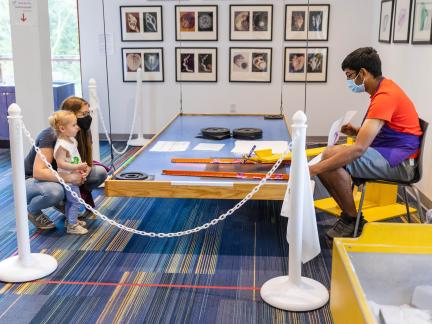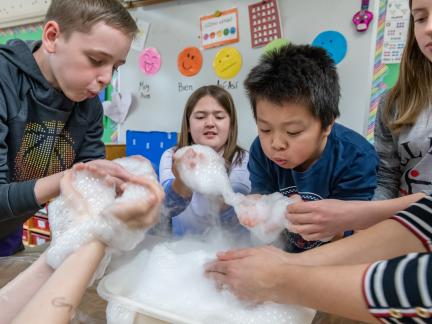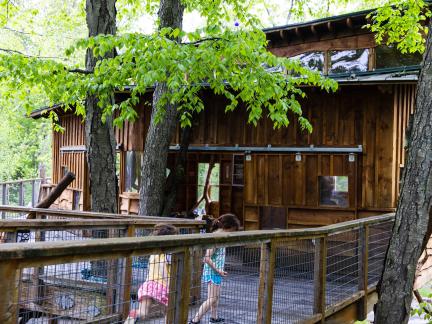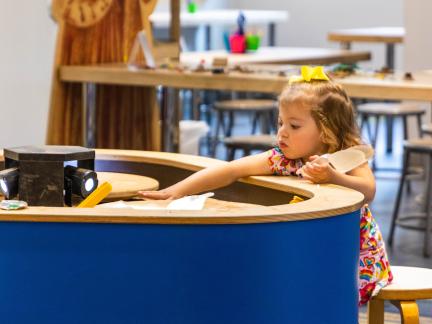Do We Have To Leave? When 6th Grade STEAM Students Come To Play and Learn
As I make my way around the museum floor, I see eight students huddled around our three Sand Spinners, focused on the patterns they are creating together. I mentally note that they have been there for a while—a good sign of student engagement. I head outside and notice four students cooperating to keep the gravel wheel operating continuously. This is a new endeavor I haven’t seen undertaken before, and I have fun watching them work towards their self-imposed goal.
Both inside and outdoors, the students’ focus is palpable, as is their enjoyment. So when the teachers announce it is time to board the bus to head back to middle school, I hear some cries of protest and witness some dragging of feet. And I smile.
Sixth graders complaining about leaving a museum too soon? I’m okay with that. We know the Discovery Museum is serving its purpose when we hear that our visitors can’t get enough of engaging in engineering design, experiencing the power of water and air, creating patterns in spinning sand, and identifying and copying the geometry in dances from around the world.
Here at the Museum, we strive to complement the hard work teachers do in the classroom by providing another avenue to learn STEAM concepts. We want to lift STEAM content off the textbook pages and worksheets and put it in motion and in 3D and in color, because STEAM can be a full-body experience.
Diane Crampton, a veteran 6th grade teacher, has been bringing her students to Discovery Museum for the past six years. When I ask her what brings her back year after year, she points to that beautiful and natural relationship between science and action.
“Just about everything [at the Museum] is hands-on or interactive in some way,” Diane tells me. “There is no better way to engage and challenge the students. The variety of exhibits is impressive. Overall, it is always a great experience for both the students and me.”
For these middle school students, a Discovery Museum Field Trip offers the time and resources to experiment with familiar concepts in hands-on ways, the freedom to pursue one’s own line of questioning, and the means to play with and explore ideas introduced in the classroom in a novel environment.
For instance, one group of students can be learning about the visible spectrum of electromagnetic waves by mixing different wavelengths of light and observing the resulting colors, while another group is building a pulley as tall as themselves out of loose wooden and plastic parts. Students interested in sustainability can spend time in the da Vinci Workshop, creating models, art, and contraptions out of cardboard, paper, plastic caps, egg cartons, and other recycled materials. And in true da Vinci style, they can even prototype flying machines and see how high they soar using our Vertical Air Stream exhibit.
“You are never too old to play,” Diane says. “[While at the Museum] the students can work on teamwork and on encouraging one another to take risks—it is good practice for collaboration, determination, and sharing, as the students explore and experiment.”
Before the Field Trip, Diane goes over expected behaviors and rules with her 6th graders, and shows exhibit photos to give them a preview of what they will encounter here. After the visit, students discuss their favorite exhibits and activities, and write an “Exit Ticket” describing three things they learned. Students are also given time back at school to research any concepts they want to know more about.
Does Diane have any advice for educators considering a Discovery Museum Field Trip?
“I recommend the teachers themselves interact with all the Museum has to offer, in order to model the behaviors of exploration, risk taking, and the enjoyment of learning new things—I feel this can be contagious. Also, engage students who may seem to be taking a step back, unsure of how to perform certain experiments; encourage them to ask a staff member any time they may have a question. Finally, make connections to either classroom concepts or real-life experiences.”
We are expected to know more with age. But more important than knowing is having the skill set to transition ourselves from not knowing to knowing. This process of trying things out—the essence of the scientific method—is a natural, active, and often physical one that Diane’s students practice repeatedly during their visits. Beyond experiencing the force of air or the properties of various materials, our student visitors discover how to ask questions and explore answers. They are learning how to learn.
Considering bringing your class to Discovery Museum? Check out our Field Trips page as well as our Exhibits page to learn more. We can also help you connect our exhibits to certain Mass Curriculum Framework Standards, email kwatt [at] discoveryacton.org (Kathie Watt) for more information.
A huge thank you to 6th grade teacher Diane Crampton for sharing reflections and wisdom about her class visits to the Discovery Museum.






Comments
Add new comment